Dams, Canals Kanto Area
Boso Canal
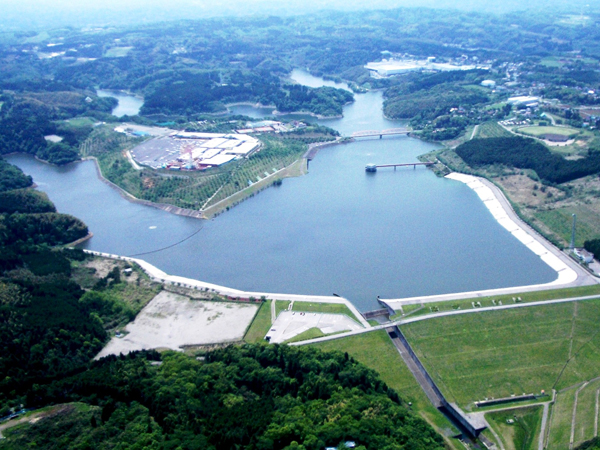
| Purpose |
|
|---|---|
| Benefited Area |
|
| Facilities |
|
| Completion | 2004 |
| Details | Boso Canal was constructed to supply Chiba coastal industrial belt along Tokyo Bay from Chiba City to Kimitsu City and their surrounding areas with industrial water and Chiba City, Kujyukuri coastal area and southern Boso area with domestic water, and its management operation started in April 2005, with the water sources from Naramata Dam and others. Canal water is taken from the right bank of Tone River at Ryoso Canal No.1 Pumping station in Sawara area, Katori City, Chiba Prefecture with max. water intake of 17.47m³/s. Then water runs through about 32km of Ryoso Canal common use facilities, about 35km of Boso Canal’s basic canal facilities and approx. 31km of Minamiboso Canal facilities to reach the destination. |
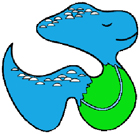
Inbacchi-kun
Location
- Address
- Oamishirasato City, Chiba Pref.
- Phone No.
- +81-475-72-4121
*Chiba Regional Water Control and Management Office / Boso Canal
Access
Train and car
Approx.20 min. by walking from Oami sta. of JR Sotobo Line
Tourist Spots
- Tokyo Water Science Museum
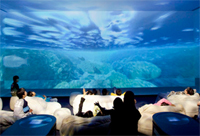 This museum is located about 10 minute walk from Kokusaitenjijyo Station near Big Site Exhibition Hall in Yumenoshima Island.To celebrate 100th water works service history, Tokyo municipal government opened this museum in 1997 at Yumenoshima Island. The entire facility is dedicated for the hands-on learning of water and how it is delivered, including the explanation of equipment and numerous facilities which make it possible to deliver safe and clean water to Tokyo. Your kids will be thrilled to learn the valuable lessons through such hands-on experiments and other experiences.
This museum is located about 10 minute walk from Kokusaitenjijyo Station near Big Site Exhibition Hall in Yumenoshima Island.To celebrate 100th water works service history, Tokyo municipal government opened this museum in 1997 at Yumenoshima Island. The entire facility is dedicated for the hands-on learning of water and how it is delivered, including the explanation of equipment and numerous facilities which make it possible to deliver safe and clean water to Tokyo. Your kids will be thrilled to learn the valuable lessons through such hands-on experiments and other experiences.
- Namikiri Fudo Temple
- Allegedly built in early Edo period, the main building of the temple stands on the cliff and is suppoted by 26 columns. As it was built on the cliff in the middle stage of the hill, overlooking the Pacific Ocean far away, it stands out in deep red color from far distance. Like Kasamori Kannon Temple building, this is also a good viewing spot for visitors, aside frrom praying.
See more ->Sanmu City - Kasamori Kannon Temple
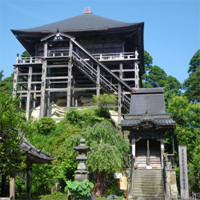 Built in 1028, main temple hall building stands atop a large rock with overhanging scaffoldings boasts of its unique only-one structure. This all-sides hanging on the cliff shape attracts many visitors.
Built in 1028, main temple hall building stands atop a large rock with overhanging scaffoldings boasts of its unique only-one structure. This all-sides hanging on the cliff shape attracts many visitors.
Photo by "Kasamori-Kannon Temple Japanese" HP
See more ->Kasamori-Kannon Temple Japanese
Events
- Oguri Hangan Festival [Beginning of December]
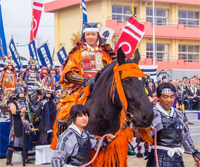 This festival started in 1989 re-enacting a legend of Oguri Hangan in Kyowa district.
This festival started in 1989 re-enacting a legend of Oguri Hangan in Kyowa district.
At the site, traditional arts are performed such as a sacred music and dance called "Oguri Daidai Kagura", which is an intangible folk cultural asset of Chiba Prefecture, and "Chigyo Yagibushi" dance. Refreshment booths and farm stands are also set up.
The highlight of the festival is the Samurai warrior parade, which is like a gorgeous picture scroll of Warring States period. "Oguri Hangan" dressed in a Samurai costume on horseback and princess "Teruhime" riding on a court carriage are followed by 200 people dressed as maids, four heavenly kings, ten braves, and children samurai, rolling on Nihari Station road.
Photo by "Chikusei City Tourism Association" HP
See more ->Chikusei City Tourism Association (Only Japanese)- Ring Ring Festa - Cycling in Kasumigaura, Tsukuba [Middle of October]
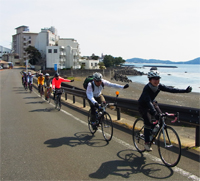 This event is held to encourage more cyclists to come to the Kasumigaura and Mt. Tsukuba area. During this event, free rental bikes and cruise ships transportation services are provided for the convenience of the cyclists to load the bikes to cut short of part of the bike trails or even enjoy the cruise with their bikes on the ship. Bicycle makers also provide trial bike ride opportunities for adults and bycycle riding classes for children, too. Some shows are also staged.
This event is held to encourage more cyclists to come to the Kasumigaura and Mt. Tsukuba area. During this event, free rental bikes and cruise ships transportation services are provided for the convenience of the cyclists to load the bikes to cut short of part of the bike trails or even enjoy the cruise with their bikes on the ship. Bicycle makers also provide trial bike ride opportunities for adults and bycycle riding classes for children, too. Some shows are also staged.
Photo by "Tsukuba-Kasumigaura Cycling" HP
See more ->Tsukuba-Kasumigaura Cycling (Only Japanese)- Ayumi Festival [On 16 August every year]
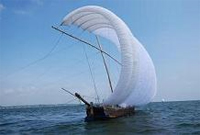 This festival has its origin in the festival of Ayumizaki Kannon (Buddhist deity of mercy). It begins from the annual ceremony of exhibiting the Buddhist image, then are followed by various events such as dances and musical performances on stage, performance of Hobiki Bune boats, which uses their sails with the wind to draw their nets, and fireworks over the lake. Many people visits the festival where agricultural and fishery products are sold and/or distributed, and many refreshment booths are set up.
This festival has its origin in the festival of Ayumizaki Kannon (Buddhist deity of mercy). It begins from the annual ceremony of exhibiting the Buddhist image, then are followed by various events such as dances and musical performances on stage, performance of Hobiki Bune boats, which uses their sails with the wind to draw their nets, and fireworks over the lake. Many people visits the festival where agricultural and fishery products are sold and/or distributed, and many refreshment booths are set up.
Photo by "Kasumigaura City Tourist Association" HP
See more ->Kasumigaura City Tourist Association (Only Japanese)

 Sitemap
Sitemap

